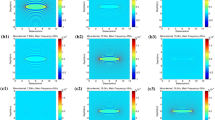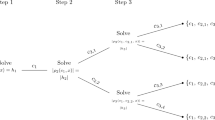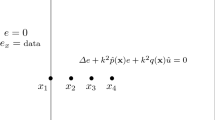Abstract
—We investigate a new nonlinear inversion method for low frequencies to determine the bulk and shear modulus as well as the material density and the location of subsurface inhomogeneities. The solution is a direct exact nonlinear inversion of single scattered waves containing near- and far-field terms for incident P and scattered P and S waves, allowing for inversion of parameters in the vicinity and at distance from the sources and receivers. Because the approach is based on single scattering theory, the range of application includes single strong scattering anomalies of various sizes like magma chambers, gas- or fluid-filled cavities, or buried near-surface obstacles. The replacement of the material properties by a new set of parameters, referred to as scattering factors, allows the inverse problem to be solved analytically. The nonlinear nature of the scattering problem is investigated and implications for the inversion process are discussed. The deviations in the elastic parameters as a function of the scattering factors show a strong asymmetry about zero, and therefore linearized approximations will perform differently, depending on the sign of the perturbation. Based on the low frequency (Rayleigh) approximation, we introduce and evaluate a pair of approximations (Mie) derived by numerical and analytical integration of the Rayleigh approximation. Both approximations are based on the underlying principle of subdividing the inhomogeneities into a number of small noninteracting parts and subsequent integration over the total volume, thus increasing the Rayleigh limit and producing better resolution of the parameter estimates during the inversion. The two Mie approximations, when evaluated as a function of scattering angle and distance, produce similar results in the mid- and far-field of the inhomogeneity and reveal better resolution than the Rayleigh approximation. For three anomalies of ± 50% in bulk modulus, shear modulus, and density, the relative error between the exact solution and the two Mie approximations remains below 10%, 20%, and 30%, respectively, for values of k p R < 3.0, where R is the radius of the heterogeneity. However, smaller errors for individual cases are found for values up to k p R≈ 4.5. The performance of the inversion based on the analytically and the numerically integrated Mie approximation is tested for single parameter perturbations, revealing reliable and stable inversion results for the bulk and the shear modulus, reasonable results for the density, and crosstalk between the shear modulus and the density. The results show well-defined locations of the anomalies and slight deviations in the estimates of their magnitudes, which can be explained by amplitude and phase deviations between the analytical solution used for forward modeling and the approximations used for the inversion. The analytical Mie approximation provides a fast means to estimate elastic parameters compared to the more time consuming numerically integrated approximation, while the latter can be applied to more arbitrarily shaped inhomogeneities.
Similar content being viewed by others
Author information
Authors and Affiliations
Additional information
Received March 25, 1998, accepted January 22, 1999
Rights and permissions
About this article
Cite this article
Gritto, R., Korneev, V. & Johnson, L. Nonlinear Three-dimensional Inversion of Low-frequency Scattered Elastic Waves. Pure appl. geophys. 156, 557–589 (1999). https://doi.org/10.1007/s000240050313
Issue Date:
DOI: https://doi.org/10.1007/s000240050313




